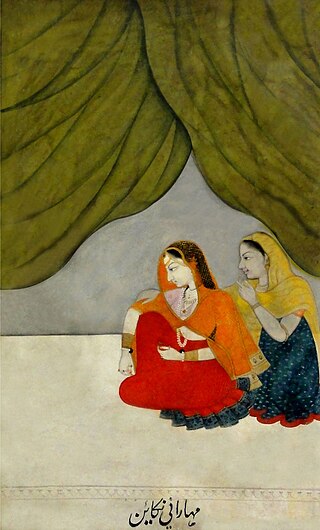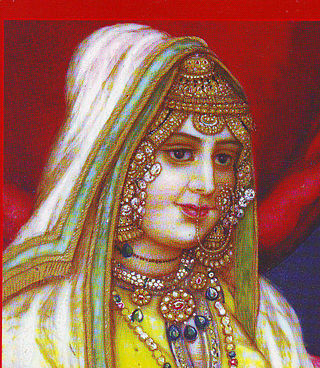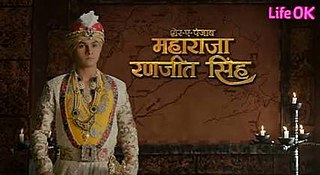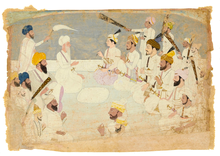
Maha Singh, also spelt as Mahan or Mahn Singh, was the second chief of the Sukerchakia Misl, which as a Sikh grouping with its guerilla militia was one of twelve Sikh Misls that later became part of the Sikh Empire. He was the eldest son of Sardar Charat Singh and Sardarni Desan Kaur Warraich. He was the father of Sher-e-Punjab Maharaja Ranjit Singh.

The Kangra Fort is a historic fort located in the Kangra district of the Himachal Pradesh state in India. The fort is also known as 'Nagarkot' and 'Kot Kangra'. This fort stands on a hillock between two rivers, among the foothills of the Dhauladhar range. The fort is the largest in the Indian Himalayas, and is under the protection of the Archeological Survey of India. The Kangra Fort is also the oldest fort in the Himalayas and, according to Indian mythology, has a legendary history spanning approximately 4,000 years.

Jassa Singh Ramgarhia (1723–1803) was a prominent Sikh leader during the period of the Sikh Confederacy. He was the founder of the Ramgarhia Misl.

Maharani Datar Kaur (born Bibi Raj Kaur Nakai; was the queen consort of Maharaja Ranjit Singh, the founder of the Sikh Empire and the mother of his successor, Maharaja Kharak Singh. She was the daughter of Sardar Ran Singh Nakai, third ruler of the Nakai Misl and Sardarni Karmo Kaur.

The KanhaiyaMisl was one of the twelve misls of the Sikh Confederacy. It had been founded by Sandhu Jats.

Sardar Charat Singh, also romanised as Charhat Singh, was the founder of Sukerchakia Misl, father of Mahan Singh, and the grandfather of Ranjit Singh, the first Maharaja of the Sikh Empire. He distinguished himself at an early age in campaigns against Ahmad Shah Abdali and along with 150 horsemen split from the Singhpuria Misl to establish the Sukerchakia Misl, a separate grouping with its distinct guerilla militia.

Rani Sada Kaur was a Sikh leader. She served as the Chief of the Kanhaiya Misl from 1789 to 1821, following the death of her husband Gurbaksh Singh Kanhaiya, the heir to Jai Singh Kanhaiya, the leader of the Kanhaiya Misl, and she is sometimes referred to as Sardarni Sada Kaur.

Jodh Singh Ramgarhia was a prominent Sikh leader of the Ramgarhia Misl in the Punjab, the son of Jassa Singh Ramgarhia who inherited Jassa's position on his death in 1803. His Ramgarhia followers played an important role in the struggle when Maharaja Ranjit Singh was establishing the Sikh Empire.

Maharani Mehtab Kaur was the first wife of Maharaja Ranjit Singh, the founder of the Sikh Empire. She was the mother of Maharaja Sher Singh, who briefly became the ruler of the Sikh Empire from 1841 until his death in 1843.

Ramgarhia Misl was a sovereign state (misl) in the Sikh Confederacy of Punjab region in present-day India and Pakistan. The misl's name is derived from Qila Ramgarh, a place located in Ramsar, near Amritsar, which was fortified and redesigned by Ramgarhia Misl chief Jassa Singh Ramgarhia. The Ramgarhia Misl was one of the twelve major Sikh misls, and held land near Amritsar.

Gurbaksh Singh Kanhaiya was the eldest son and heir of Jai Singh Kanhaiya, the chief of the Kanhaiya Misl. He was the father of Maharani Mehtab Kaur and thus, the father-in-law of Maharaja Ranjit Singh, the founder of the Sikh Empire.
Rani Raj Kaur was the wife of Maha Singh, the leader of the Sukerchakia Misl and the mother of Maharaja Ranjit Singh, the founder of the Sikh Empire. She was affectionately known as Mai Malwain after her marriage. She is also referred to as Sardarni Raj Kaur and Rajkumari Bibiji Raj Kaur Sahiba before marriage. She was the daughter of Raja Gajpat Singh of Jind.

Sher-e-Punjab: Maharaja Ranjit Singh is an Indian historical drama based on the life of Maharaja Ranjit Singh (1780 –1839), the founder of the Sikh Empire, which ruled the northwest Indian subcontinent in the early half of the 19th century. The series stars Damanpreet Singh, Tunisha Sharma, Shaleen Bhanot, Rumi Khan, Sonia Singh, Sneha Wagh and Chetan Pandit.
Sardarni Desan Kaur Waraich, also known as Mai Desan was the regent of the Sukerchakia Misl during the minority of her son from 1770. She was the wife of Sardar Charat Singh and the mother of Sardar Maha Singh. Her grandson, Maharaja Ranjit Singh, was the founder of the Sikh Empire.
Mian Ghaus Khan, better known as Mian Ghausa, was a Punjabi Muslim who served as an artillery officer for Sardar Maha Singh of Sukerchakia Misl and later his son Ranjit Singh, founder of the Sikh Empire.

Haqiqar Singh Kanhaiya was the cousin of Jai Singh Kanhaiya, founder and leader of the Kanhaiya Misl, a grouping of Sikhs with a distinct guerilla militia. He founded a village named Sangatpur.
The Battle of Achal was fought in Batala in 1785 between the Sukerchakia Misl and Afghans, supported by the Ramgarhia Misl, alongside Sansar Chand,

The Hill States–Sikh wars, also known as the Sikh–Pahari Raja wars, was a set of battles and conflicts fought by the Sikhs and the rajas (kings) of the Hill States located in the Sivalik Hills.

Bhag Singh Ahluwalia (1747-1801) was a Sikh leader, military commander, and head of the Ahluwalia Misl.
















